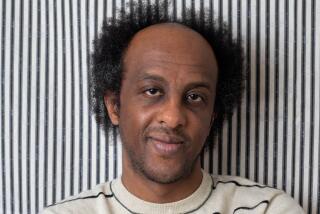Transplanted Ethiopians are driven to succeed : Taxis are among their most visible enterprises in the nation’s capital.
- Share via
WASHINGTON — When Teigistu Lemma began driving a cab in this city of sweltering summers, he would occasionally complain to his passengers about the heat and humidity.
“But you’re from Africa,” they would respond incredulously. “How can you find it hot here?”
Lemma would laugh. His customers did not know that Addis Ababa, the Ethiopian capital city he called home, is situated 8,000 feet above sea level, in a country of mountainous terrain and temperate climate.
More than likely, his fares were not aware that Washington is home to an estimated 20,000 Ethiopians, the largest number in any city in the United States (Los Angeles has the second-largest Ethiopian population).
The Ethiopian community is so large, in fact, that the taxi company Lemma drove for was one of four Ethiopian-owned cab companies in the district.
“You are in America, you are in Washington, but sometimes you think you are in Ethiopia,” said Lemma, who is now general manager of the Red Sea Cab Co., which employs 70 Ethiopian drivers. “Sometimes I can go a whole week and not speak English, only Amharic (Ethiopia’s dominant tongue).”
Ethiopians first began coming here on student exchange programs in the 1950s. Following the 1974 fall of Emperor Haile Selassie’s government, which led to a period of anarchy and repression culminating in the establishment of a Communist military dictatorship, the influx increased to flood-like proportions.
A long-running civil war between Ethiopia and Eritrea, a province on the Red Sea, added to this outward migration--an estimated one-quarter of the Ethiopian community is Eritrean.
Washington was attractive to the migrants for many reasons:
They felt more comfortable in a predominantly black city, one that has a large number of entry-level service jobs.
Lemma said that an Ethiopian infrastructure also meant that “there’s this communal welfare--an Ethiopian without a job will not go to social services, but they will go to their friends.”
Ethiopians tend to differ from other immigrant groups in two key respects: They are overwhelmingly male and highly educated.
A 1987 study of the community found that 65% had at least one year of post-secondary education, and 30% worked in professional/management jobs (8% drove taxis).
Lemma has a master’s degree in economics, and Yetbarek Herouy, who co-owns the Red Sea Cab Co., estimates that most of his employees drive taxis to help pay their way through college.
Lemma and Herouy represent, in microcosm, the divergent paths members of the Ethiopian community have taken to get here. A political activist who had gone to Minnesota as an exchange student during his senior year in high school, Lemma went underground in 1976 when the Ethiopian military began purging the nation’s intellectuals.
In 1979, after walking for five days, he escaped into Sudan. After short stays there and in Italy, he was admitted to the United States and went to live with his old Minnesota sponsors, who had relocated to Anchorage.
Lemma lived there for a year, then moved to Washington when he was accepted into a degree program at American University. He drove a cab while attending school, and even though Lemma subsequently received a master’s degree, he has not found work in his field.
Herouy said he left Ethiopia in 1972 because “I was young, there was no future for me, and there were no jobs.” Emigrating to Israel, where his sister attended college, he worked as a seaman on a merchant vessel.
In 1977, Herouy moved to New York, where for nearly 13 years he worked as a furrier. When the business went under he moved to Washington, attracted to the city by his knowledge of its large Ethiopian community.
About eight months ago, after working for a while in a convenience store, he and a friend purchased the cab company.
Since that time, says Herouy, Red Sea Cab has expanded from 19 vehicles to its current high of 80 (six of Red Sea’s drivers are Nigerian and four are Somali).
Ethiopian visibility in the nation’s capital is primarily a function of taxi drivers and native restaurants (there are at least 20), particularly those in the trendy Adams-Morgan neighborhood.
There, elegantly dressed men sit around eateries with names like Red Sea and Meskerem, using their pancake-like injera bread to scoop up spicy lamb dishes as they discuss the latest political developments in their homeland.
With the 1990 fall of the Communist government and the subsequent end of the civil war, a lot of this talk centers on whether or not to return to Africa.
Lemma and Herouy say they will at least visit Ethiopia in the near future. But, says Herouy, “a lot of people are going back (for good), especially the Eritreans. They don’t fear going to prison any more, or getting killed. And there’s no longer any famine.”
More to Read
Sign up for Essential California
The most important California stories and recommendations in your inbox every morning.
You may occasionally receive promotional content from the Los Angeles Times.










